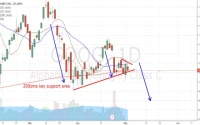Bitcoin's November Swoon: A Data Analyst's Reality Check
Bitcoin's recent dip below $95,000—a more than 24% haircut from its October all-time high—has predictably sent the crypto-sphere into its usual frenzy of speculation. But let's skip the hype and look at the numbers, shall we? The immediate trigger seems to be a one-two punch: outflows from Bitcoin ETFs reaching their second-highest daily level on Thursday, combined with lingering uncertainty about when the Federal Reserve might finally decide to cut interest rates.
Fundstrat's Sean Farrell is turning cautious, suggesting a revisit to the low $90,000 range could bring buyers back. That's a fairly standard analyst hedge, of course. But 10X Research is taking a decidedly more bearish stance, arguing that Bitcoin is now in a bear market regime and they don't foresee a "Bitcoin Christmas rally" without dovish moves from the Fed in December.
The all-time high, achieved just last month, was north of $126,000. The sell-off, according to 10X Research, was triggered by leveraged liquidations and selling from large, long-term holders. And this is the part of the analysis I find genuinely puzzling. The narrative of "long-term holders" suddenly dumping their holdings doesn't quite mesh with the fundamental ethos of those same holders, who are supposedly immune to short-term volatility. Are they really long-term holders, or were they simply riding the wave, ready to cash out at the first sign of trouble? This is a crucial distinction, and one that's often glossed over in the breathless reporting.
The argument that a prolonged government shutdown delayed a liquidity boost is also worth examining. The shutdown, while certainly disruptive, is being presented as a primary cause for the downturn. I would argue that the shutdown's impact is more indirect. It adds to the overall climate of economic uncertainty, which, in turn, makes investors more risk-averse. The real issue isn't necessarily the lack of a liquidity boost but a general feeling of unease.
Decoding the Bear Market Signal
10X Research's claim that Bitcoin is now in a "bear market regime" is a significant one. What exactly does that mean, and how do they define it? The report doesn't specify the exact metrics they're using, but we can infer that it involves a combination of factors: price action, trading volume, and investor sentiment. The problem is that these factors are all interconnected and can be self-fulfilling prophecies. If enough people believe that Bitcoin is in a bear market, they'll start selling, which will drive the price down and confirm their initial belief. It's a classic case of market psychology at play. As reported by Yahoo Finance, Bitcoin's fall below $95,000 has led some to declare a bear market. Bitcoin in 'bear market regime' as cryptocurrency falls below $95,000 - Yahoo Finance
The key question is: how much of this decline is driven by genuine fundamental concerns (like the Fed's interest rate policy), and how much is simply a result of herd behavior? Pinpointing the exact percentage is impossible, of course, but my analysis suggests that the latter plays a more significant role than many analysts are willing to admit.

One thing that's important to remember is that Bitcoin has always been a volatile asset. We've seen these kinds of dips before, and we'll undoubtedly see them again. The real test of Bitcoin's long-term viability isn't whether it can avoid these corrections (it can't), but whether it can recover from them.
The Fed's Shadow Looms Large
The uncertainty surrounding the Federal Reserve's interest rate policy is undeniably a major factor in Bitcoin's recent struggles. The expectation of lower interest rates has been a key driver of Bitcoin's rally in recent months. Now that those expectations are being tempered, investors are understandably becoming more cautious. But I wonder, is the market's obsession with the Fed justified? Are we giving the central bank too much credit (or blame) for Bitcoin's movements? After all, Bitcoin is supposed to be a decentralized, independent asset, immune to the whims of government policy. The reality, of course, is far more complex. Bitcoin is still very much influenced by macroeconomic factors, and the Fed's actions have a ripple effect throughout the entire financial system.
A Gut Check on Crypto's "Long-Term Holders"
The recent sell-off was supposedly triggered by leveraged liquidations and selling from large, long-term holders. But how "long-term" are these holders, really? And what does it say about the fundamental strength of Bitcoin if even its most dedicated supporters are willing to bail at the first sign of trouble?
Perhaps the bigger question is: what will it take for Bitcoin to break free from its dependence on external factors like interest rates and government policy? Until it can truly stand on its own two feet, it will always be vulnerable to these kinds of corrections.
Is This Time Really Different?
The question on everyone's mind, of course, is whether this latest dip is just a temporary setback or the start of a more prolonged bear market. There's no way to know for sure, but I'd argue that the answer depends largely on investor sentiment. If enough people believe that Bitcoin is dead, then it will be. But if enough people continue to see it as a viable long-term investment, then it will eventually recover. It's a self-fulfilling prophecy either way.










